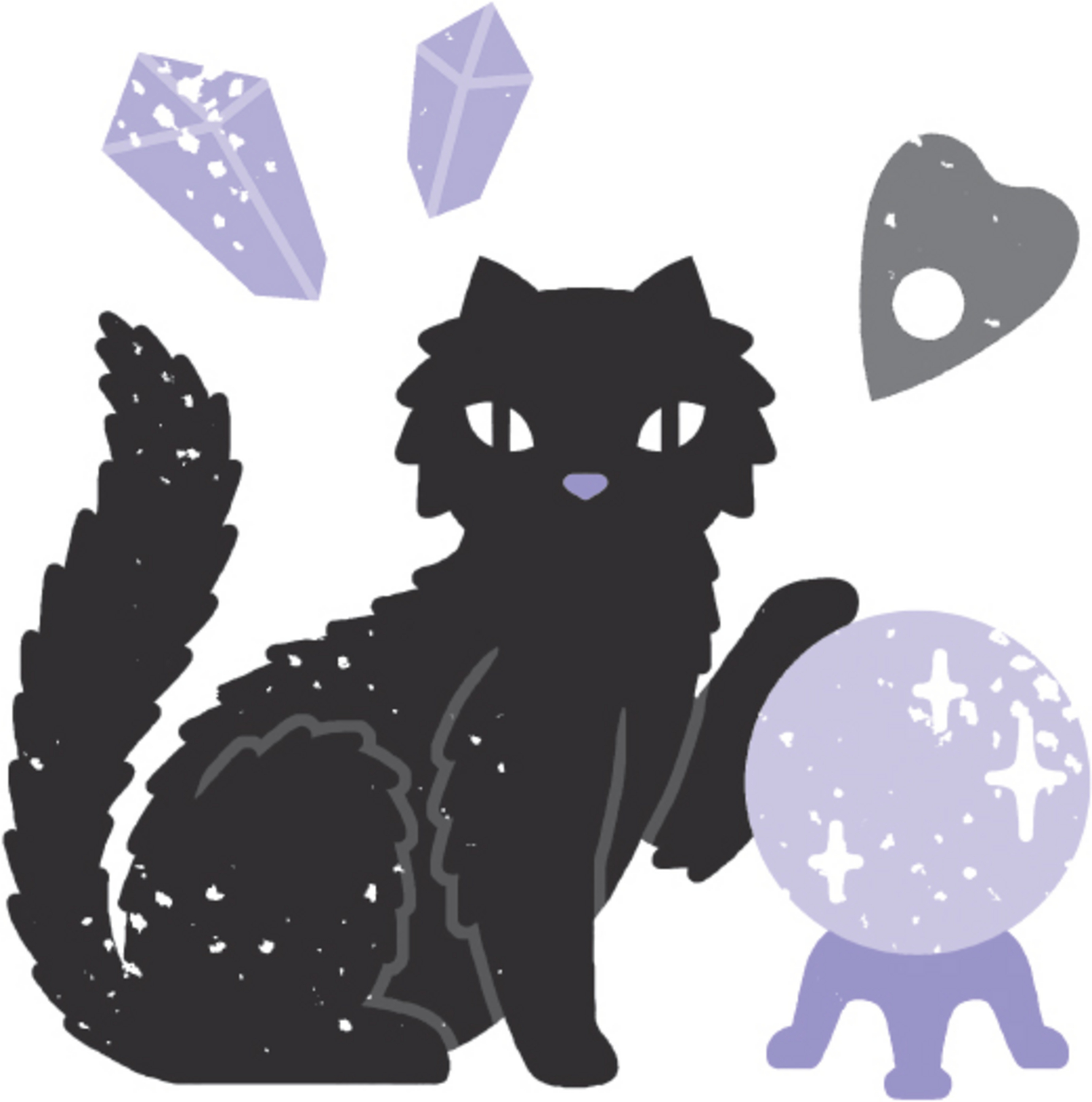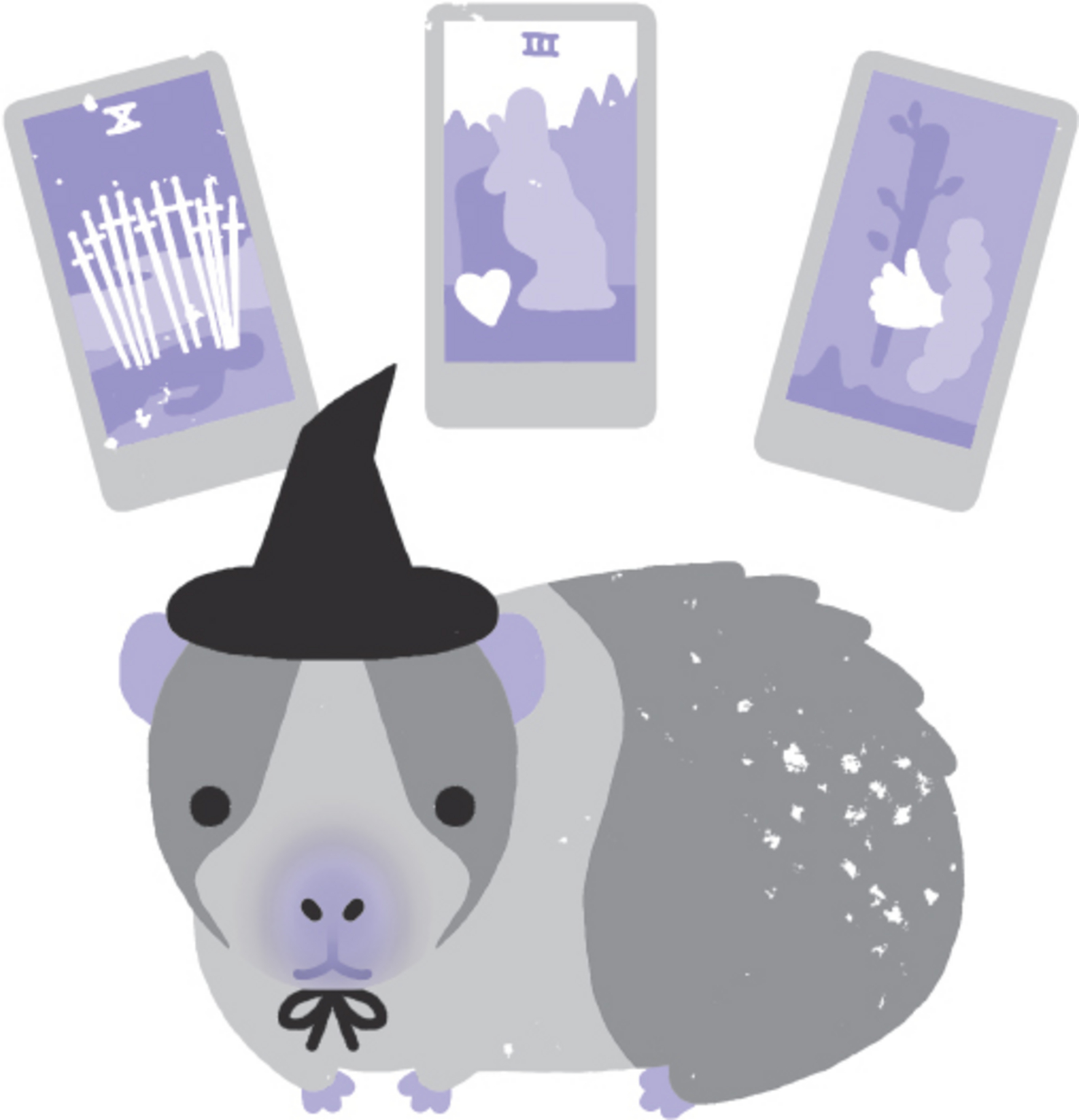

We think of the witch as a solitary creature. She lives alone on the edge of town in a ragged house surrounded by weeds, emerging only at night, happily separated from other living beings (save maybe a cat or a newt). But nothing could be further from the truth: witches love to travel in packs, or, as we call them, covens.
Finding a group of like-minded people to share your feelings, passions, and powers with is not something that happens all of a sudden. There’s not a store where you can just pick up a set of friends (though there are apps, which is sort of the same). Cultivating a strong social circle is an active process. Your coven isn’t just the group of people who happen to show up in the same places as you do, but the people you’ve chosen to devote part of your heart and mind (and schedule) to. You will not always agree with them. You may not always understand the decisions they make. They will not always make you happy (though if they’re making you miserable, you may want to reevaluate). But in the end, they are the people you show up for.
Covens aren’t necessarily intuitive, either. Many people like to have a “best friend,” but there’s more to your coven than your favorite, closest pal. The people you choose to join you will have different purposes at different times. Sometimes your energies will be synced with one person more than others, and sometimes others won’t be as connected to one another as they are to you. But your coven is your team. Together, you’re greater than any one—or even any two—of you alone.
In this chapter, we’ll talk about seeking out and evaluating potential friends, navigating jealousy and competitiveness, healing conflicts, and joining forces with the weird sisters who recognize your powers. Maintaining a coven requires selflessness, compromise, and deep empathy. But when done right, all of that energy is reciprocal and comes back many times over. If these are the people you show up for, they are also the people who will show up for you, at your best and at your worst, however you grow and change. No matter what happens, they will be there for you, ready to strip and dance naked in the woods.

How to Build a Coven

Good coven-building relies on one of the core pillars of many witchcraft practices: the rule of threes, also known as the threefold law or the law of return. Basically, whatever energy you put into the world, you will receive in return three times stronger. This rule is good to keep in mind no matter what you’re doing, but especially when making friends.
Everyone understands that if you’re a thoughtful, caring person you tend to attract thoughtful, caring people, and if you’re mean and vindictive, it’ll eventually come around to bite you in the ass. But the rule of threes adds an urgency to that common knowledge. When building a coven, the rule of threes applies not just to energy, but actual people. If you lie about who you are and don’t treat the people in your life well, you may soon find yourself surrounded by people treating you three times worse than you ever treated anyone—or worse, surrounded by no one at all.
 Start with your present coven.
Start with your present coven.
Because you’re old enough to read a book independently, you’ve likely lived long enough to pick up a few friends. If these friends have been close and cool and loyal from day one, and you can share your deepest feelings and fears with them, then fantastic. Keep doing what you’re doing.
However, maybe you’re not comfortable with the friends you have right now. That happened to Jaya in middle school. Her group of friends said they loved her but put her down for her appearance, weight, interests, and basically anything else they could pick on. She was afraid to tell them she was hurt, felt pressured to do what they told her, and never really felt like they would be there for her in a crisis. But she ignored those feelings, because these were her friends. They had been around for years, and starting over seemed scary. Salvation came in the form of a new school, summer camp, and a group of people who accepted Jaya for her complete, weird self. But it also came as Jaya began to realize what made her her. This included surface stuff like music tastes and fashion choices, but also her particular way of looking at the world.
In terms of the rule of three, it’s not just good energy but your own unique energy that brings back good returns, in the form of others who truly understand you. If you’re getting back nothing but negative vibes, you may be wasting your aura on the wrong crowd. Being yourself isn’t just a statement or a boost for your self-esteem, it’s literally attractive—it brings people toward you.
 Find where they’re hiding.
Find where they’re hiding.
Because friendships often begin with shared interests, spend time in places and doing activities you enjoy. You could meet a potential new coven-mate at a play or at a concert, on a sports team or in a hiking club, or at a Magic: The Gathering competition at your local comic book store. Surface interests often correlate with deeper similarities.
If you’re not the club-joining type, identify someone in your life who seems cool that you want to get to know better. All good relationships balance self-acceptance and growth, after all. A truly powerful bond will leave you feeling as comfortable as possible with yourself (because no one feels comfortable with themselves 100 percent of the time), but also open to change. Good friends won’t ask you to apologize for the things you love and will lead you to new things you don’t know you love yet.
 Practice patience.
Practice patience.
Assembling a coven doesn’t happen overnight. You won’t show up on the first day of volleyball practice and walk away with a new best friend for life. In fact, one of the best pieces of advice Jaya was given when headed off to college was not to try to make friends, which seems counterintuitive. The logic went that, especially in a dorm-room setting, making fast friends is easy (and fast friends are okay!), but if you can slowly get to know people, quality connections will reveal themselves. (It totally worked.) Divining who is truly coven-worthy takes time. If hanging out with someone leaves you feeling powered up, excited, or relaxed, that’s a strong sign that this person is compatible. If afterward you’re drained, anxious, or even bored, they might be sapping you of strength instead.
 Be bold.
Be bold.
Asking someone to get closer to you can be scary, like asking someone on a date. But if you have the courage to take that risk, your effort will be returned to you threefold. The easiest way to bridge the gap is to move forward. Ask them to hang out, invite them places you’re going, get their number and start texting them. Pay attention to how they react to your advances; tune in very carefully to their energy and use it to bolster your own feelings of friendship and connection. Even if the friendship doesn’t become super-close super-fast, you’ll have increased your powers of self-confidence simply by putting them into practice.
 Don’t curse your chances.
Don’t curse your chances.
If you’ve been less than perfect in your past relationships—whether you were your high school’s mean girl or a total outcast—you’re not doomed to be lonely forever. You can still find a stronger, more nurturing community whenever you’re ready to seek it out. Tap deep into your psyche and become especially aware of your actions. How are you treating people? Are you being there for them like you want them to be there for you? If what you’re doing came back to you threefold, how would you feel?
Most importantly, you must trust in your magic. Insecurity over making friends often stems from fear that you have nothing to offer, that no one would want to join your coven. But people are out there who match your magic, and they will not only value it but be energized by it. Sharing and affirming the essence of who you are may take time and it may take work, but it is always worth it.

 |
WITCH HISTORY THE WOMEN’S INTERNATIONAL TERRORIST CONSPIRACY FROM HELL |
 |
ON HALLOWEEN MORNING, 1968, thirteen women dressed as witches marched toward the New York Stock Exchange—dancing, singing, and carrying a papier-mâché pig’s head on a platter. After telling security that they had an appointment with “the Boss, Satan,” the women made their way to the trading floor, where they hexed the entire enterprise. The market closed that day 1.5 points down and dropped a further five points the next day.
This group of activists, known as the Women’s International Terrorist Conspiracy from Hell (get it?), was active only for a few years in the late 1960s, but in that time it used magic and mischief to protest capitalism, patriarchal beauty standards, and the institution of marriage. The first W.I.T.C.H. coven was founded by New York City feminists who found local activism too serious and not mischievous enough, and soon sister covens popped up in other cities. These thirteen-member groups would get together to cast hexes on symbols of oppression, ranging from the presidential inauguration to beauty pageants to the Chicago Transit Authority after a fare hike.
Their approach was certainly radical at the time, but in many ways, the tactics of W.I.T.C.H. seem almost embarrassingly retro now. The group’s manifesto talks about “gypsies,” a term now understood to be a racist slur against the Romani people. It attacked women for participating in the sexist system of marriage—the New York coven infiltrated a bridal show held in Madison Square Garden, chanting “Here come the slaves, off to their graves” and papering the city with stickers saying “Confront the Whore-Makers at the Bridal Fair”—although original member Robin Morgan wrote in her 1977 book Going Too Far: The Personal Chronicle of a Feminist, “We thought it would be clear that this time we were blaming the men who forced women into the institution of marriage, not pillorying the women. We might have realized that brides-to-be don’t like being called whores.” (Of course, even using “whore” as an insult is retro; many feminists today support sex workers, and don’t call them names either.)
Still, in other ways W.I.T.C.H. was astonishingly modern. “If you are a woman and dare to look within yourself, you are a Witch. You make your own rules. You are both free and beautiful. You can be invisible or evident in how you choose to make your witch-self known,” read the group’s manifesto. “Whatever is repressive, solely male-oriented, greedy, puritanical, authoritarian—those are your targets….Your power comes from your own self as a woman, and it is activated by working together with your sisters.” We can’t argue with that—that’s the kind of witchcraft this book is all about.


A TAROT RITUAL TO
Attract Friendship
Like a love spell, this ritual will not blindly bind someone to you, but make you the most attractive version of yourself. You’ll use the symbolism of the tarot to channel your energy into your future relationships. |
WHAT YOU’LL NEED: A deck of tarot cards (find them in bookstores, specialty shops, or online) A fancy goblet (or cup) of water |
Remove the Three of Cups and the Sun from the tarot deck. The Sun, when upright, represents optimism, fulfillment, and the happiness that comes from being one’s truest self. It symbolizes who you are in your friendship journey. The Three of Cups represents friendship, community, and the celebration of those things. It symbolizes where you want to wind up in your journey.
Sitting on the floor, make a triangle with the cards and your body, with the Sun to your upper left and the Three of Cups to your upper right. Place the goblet of water in the middle of the triangle. Close your eyes, and picture a strand of gold thread connecting you to the Sun, charging the card with all the attributes you’ll bring to any new friendship. Then picture that thread extending from the Sun to the Three of Cups, taking your energy out into the community. Finally, join the thread from the Three of Cups back to you, so that the positive energy you put into the Sun is now flowing back to you through friendship.
Sit for as long as you need to more clearly envision your future, in which you’re opening yourself up to the world and receiving love and trust in return. When you’re done, pick up the goblet and drink the water. Carry the two cards with you until you start making connections.

The Transformative Power of Vulnerability

Meeting new people, making overtures, and building familiarity take work, and once you’ve forged a friendship, you may be tempted to treat it like a fragile treasure. You get anxious about putting any kind of pressure on the relationship—after all, if it breaks, you have to start all over again. But you can’t have a whole, true, nourishing friendship if you’re frightened to ask for anything or show your darker side. Luckily, witches don’t shy away from demons—they consort with them, not only bravely but merrily. Members of a strong, supportive coven will help you figure out how to recognize your demons, resist their worst influences, and even dance alongside them. At the very least, your coven should be willing to invite your demons to happy hour. But there’s no way to confront these agents of darkness without being open, honest, and vulnerable.
Not all decent friendships delve into dark territory. But being able to admit to being scared, or sad, or uncertain, or hurt, or haunted by the past can add a special dimension to a friendship (and a romantic relationship; more on that in the next chapter).
So how do you start being vulnerable? Here are some ideas.
 Create space to summon demons without fear.
Create space to summon demons without fear.
At the heart of vulnerability is openness: a willingness to reveal yourself, but also to accept others. But even more important than sharing is listening. Don’t overwhelm your friends by dumping problems on them; show yourself to be a compassionate ear, a careful thinker, an active participant in cultivating a judgment-free environment. Think back to the rule of threes: the more openness you give to others, the more you’ll receive when it’s your turn to share.
 Join in the dance.
Join in the dance.
Instead of hiding what you’re going through, bring your demon to the party and see how that feels. Does being open about a personal struggle overwhelm your group and suck all the air out of the room? Or can all of you look the demon in the eye and help each other not to flinch? Challenge yourself to acknowledge negative thoughts and feelings instead of merely sweeping them under the rug.
 Find your demons’ true names.
Find your demons’ true names.
This part of vulnerability is less about figuring out how to formally address your demons and more about exploring their nature. If you want to read about some demons with fancy Latinate names that, quite frankly, we made up, check out here—but learning to name your demons is more about recognizing their true nature. Vulnerability doesn’t mean just blurting out complaints—“I’m sad,” “I’m lonely,” “what you said made me angry,” “my knee hurts.” It means exploring and sharing the reasons behind your anger, sadness, and pain. When that’s hard to do alone, an insightful friend should be able to help. Be sincere, flexible, and willing to entertain multiple causes of (and solutions to) your problems. Opening up about a problem but then sneering at every proposed solution is not vulnerability—that’s just bitching.
 Resist the allure of wallowing (and mistreatment).
Resist the allure of wallowing (and mistreatment).
Sometimes sharing your darkest, ugliest struggles can rebound in unfortunate ways: your friend might enable further toxic thinking instead of helping you banish it, or she might simply be careless with your secrets. (If you need to establish protection around yourself, try the spells on pages 101 and 126.) Don’t kick yourself too hard. The process of opening up, regardless of the outcome, will help you learn to look your demons in the face and, eventually, dance with them on your own.
A COLLABORATIVE RITUAL TO
Deepen Friendship
Good friends create happy memories but also understand your sadness and secrets without judgment. This ritual celebrates all the many aspects at the heart of friendship. |
WHAT YOU’LL NEED: A collection of objects A cigar box or other small container |
This ritual requires prep work by both you and your friend. Before you meet, meditate on difficult memories, personal traumas, anxieties, perceived flaws, and secrets you want her to understand. (We’re calling your friend “her,” but these friendship spells work with friends of all genders.) Then find or make a small token to represent each of these experiences or qualities: create small artworks, or find inexpensive objects to represent your secrets (for example, a plastic ring could symbolize your worry about finding a life partner, a playing card could represent fear that your success is due to luck instead of skill, or a dry leaf could indicate anxiety about aging). Collect six to eight of these and put them in the box. Have your friend do the same.
Meet your friend in a quiet, comfortable, familiar place with your boxes. Explain to her what each item in the box represents, then have her do the same for her items. Then present your box to her, saying:
I give you my sadness, not as a burden but as a gift.
When your friend accepts the box, she should say:
I accept your sadness, not to cure but to protect.
Then repeat the exchange with your friend’s box of secrets.
For the following week, contemplate the items in your friend’s collection. Think about happy memories you’ve shared or future plans. Create a new association for each item she’s given you: for example, the plastic ring could be a reminder of a fun shopping trip at a flea market, the playing card could symbolize your shared love for Alice in Wonderland, and the dry leaf could represent your upcoming hiking adventure.
When a week has passed, meet your friend again in the same place. Tell her the new meanings you’ve devised for her objects. Then have her do the same for your objects.
Present your friend’s box of secrets, now a box of happy thoughts, back to her, saying:
I give you what we share together, though I still protect your sadness in my heart.
When your friend accepts the box, she should say:
I accept this as a treasure, though our bonds are both light and dark.
Repeat the exchange with the other box. Keep your original box, which now contains both your shared vulnerabilities and happiness, in a safe place in your home.

WHICH PET SHOULD BE YOUR FAMILIAR?

Cat
Pros: Low-maintenance, fuzzy, doesn’t give a shit about anyone’s opinions
Cons: Sharp, weird, doesn’t give a shit about your opinions

Dog
Pros: Unconditional love, can learn tricks, extreme power over emotions
Cons: Sorta dumb, totally filthy, will absolutely betray you to your enemies

Guinea Pig
Pros: Squeaks adorably, tolerates costumes, can easily hide while spying on people for you
Cons: No good for sawdust allergies, not good pack animals, soulless eyes

Cockatiel
Pros: Tiny dinosaur, can fly, totally punk rock
Cons: Tiny dinosaur, can be a jerk, difficult to walk

Snake
Pros: Smells with its tongue and that’s badass, scales, as venomous as my heart
Cons: Walk with its abs and that’s weird, not all are venomous, phallic

Manatee
Pros: Huggable, often mistaken for mermaids, body positive
Cons: Confined to the water, illegal to touch in Florida (but don’t touch anything in any state without its consent)
Healing Friends for Fun and Profit
HOW TO CHANNEL YOUR INNER WISE WOMAN

Emotional work—like listening, thinking, and advising—is work, though often we think of it as “just part of friendship” or “just something women like to do.” But donating comfort and solace to a friend is a labor of love, just like knitting a sweater or making a pie. The healers and wise women who were later called witches recognized the value of this effort; their life’s mission was to look after the physical and emotional health of their community, after all. But although they might have been able to cure a broken heart with a potion, or devise a ritual to ease someone’s nerves, or concoct a salve for sadness, they also expected fair compensation.
When a friend comes to you with a problem, you can imagine yourself as the village wise woman or healing crone: A young woman of the community has approached you with her problem—heartbreak, say. She has braved difficulties traveling to your hut, which is far from the village, maybe even in a perilous place, and she feels ashamed of anyone knowing that she’s there or why. But she knows she’s hurting and will take some risks to find help. She has brought payment, though not necessarily money; she knows she doesn’t owe you something just because she’s in need.
How would the village witch handle such a request?
 Affirm the difficulty of seeking help.
Affirm the difficulty of seeking help.
As we’ve seen earlier in the chapter, admitting to another person that you’re in pain is often a tremendous act of will, and the path to relief isn’t always straightforward. Don’t judge your friend for needing your healing, and don’t expect her to be able to tell you exactly what she needs. Helping her figure that out is part of the service you can provide.
 Recognize the healing value you possess.
Recognize the healing value you possess.
Often when someone is in pain, our first instinct is to say something like “I wish there were something I could do.” That may be good-hearted, but it’s also dismissive, because there is something you can do: listen, keep her company, help her think or plan or laugh or grieve.
 Use the magic words.
Use the magic words.
“Do you want advice, or do you want to vent?” “Would it help to talk more about what happened?” “What do you plan to do next?” “Do you need someone to go with you?”
MODERN CURES FOR EMOTIONAL ILLS
Potions and tinctures: Let your friend tell you her troubles over tea, cocoa, or cocktails. You’re buying.
A familiar: Invite a sad friend to play with your pets, or act as a familiar yourself by accompanying her to do an emotionally difficult task.
Curses and laughter spells: Depending on your friend’s situation, she may be aided by you expressing your anger alongside her or by you helping her to laugh and forget her troubles. If you’re not sure which, ask.
Objects of power: Thoughtful gifts and care packages sent to a distant friend are a way to help from afar.
Advice: But not scolding or lectures! If you’re not sure whether advice is welcome, you can always ask first.
 Consider your price.
Consider your price.
You don’t owe anyone free emotional labor—but you can offer the people you love a special deal. Before offering to help, consider how much it requires from you (Will you need to accompany this person somewhere? Make a difficult phone call for them? Help them draft a tricky letter?) and how much you’re likely to get in repayment (gratitude, seeing them happy, similar help from them in the future). If your assistance is grossly out of proportion with the likely payback, that’s a good way to breed exhaustion and resentment. So offer all you reasonably can and no more.
Don’t think of yourself as wise enough to be the village wise woman? Don’t let that stop you. If a friend comes to you for help, she probably considers you a healer, even if you don’t identify as an expert in emotional health. (After all, the village wise women were hardly licensed therapists.) The important thing is to put in the effort—and to recognize that helping does take effort, that it’s a kind and difficult thing you can do for a friend.
A SPELL FOR
Establishing Boundaries
In this ritual, a magic protective circle symbolizes the boundaries that keep you safe within your friendship. |
WHAT YOU’LL NEED: At least 10 index cards A pen Chalk or salt A small cup of water, if you’re using chalk 2 folders or envelopes |
Magic depends on harmony and balance, and a harmonious friendship requires balance between vulnerability and boundaries. Boundaries protect you in relationships that become emotionally unsafe, carry obligations, or take up more time and energy than you can spare. As you get closer with a friend, you will likely find that your boundaries shift.
The protective circle is a simple piece of magic popular among practicing witches and is, of course, a boundary. Whether you encounter malign forces or just need an area to concentrate and feel safe, the protective circle creates an energy space that can’t be broached—even by you, until you’ve symbolically opened a doorway. You can return to this ritual again and again as your relationship develops.
Perform this ritual in a room where the floor is easy to clean (concrete, tile, or linoleum are all good surfaces.) On each index card, write or draw one thing that a friend might ask of you, either with her or on your own. Come up with at least 10 asks, trying for a mix of ones that push your boundaries and others that don’t. Some ideas for friendship activities that usually don’t push boundaries: sharing triumphs and joys, going to a movie together, celebrating a birthday, discussing favorite books. Some ideas for friendship activities that not everyone wants to do with every friend: talking on the phone, discussing your sex lives, discussing your diets, expressing sadness or trauma, texting frequently, doing personal grooming (like waxing) appointments together. You can focus on a particular friend, tailoring your choices to your friendship, or practice the ritual for general boundary-setting, sticking to generic requests and friend favors.
With the chalk, or the salt, make a circle on the ground at least three feet in diameter. As you draw, say these words:
What I invite into my heart, let me invite it into this circle.
What I remove from this circle, let me protect my heart against it.
Stand or sit in the center of the circle. Look at each index card one at a time, picturing yourself doing the activity with another person (or the particular friend, if your ritual is specific to one person). Notice how you feel. If contemplating the card makes you feel joyful, excited, or another positive emotion, place it on the ground inside the circle. Otherwise, place it outside the circle.
When you have contemplated all the cards, open a door in your friendship circle by washing away some of the chalk with the water or by brushing away some of the salt. As you open the door, say these words:
Let my heart remain open even as I protect myself.
Let me protect myself even as my heart remains open.
You may now leave the circle. Collect the two piles of cards and store them in separate folders or envelopes. You can revisit them when you need to remind yourself of your boundaries, and you can repeat the ritual as many times as you want.


 |
WITCH HISTORY WHY WITCHES DANCE NAKED IN THE WOODS |
 |
SCANDALOUS RUMORS OF WOMEN cavorting with each other in the dark have long accompanied accusations of witchcraft. Although nakedness wasn’t considered inherently sinful in the Middle Ages—it also symbolized innocence or youth—it was regarded as outside the norm, enough to be plausible evidence of consort with the devil. Early illustrations and texts depict witches anointing their naked bodies in order to fly. The Malleus Maleficarum said witches “have often been seen lying on their backs in the fields or the woods, naked up to the very navel,” appearing to have sex with invisible demons. By the 1800s, European artists realized that “a bunch of naked women dancing madly in the middle of the night” was dynamite subject material for a painting (especially if you wanted to paint, well, a bunch of naked women) and created tableaux where the witches in question look less like withered, shameful crones and more like voluptuous, rosy-faced babes (albeit babes flying around with fire-eyed bat-demons). Other depictions of the witches’ Sabbat include in-the-buff dancing, sex, and cannibalism, each act as sinful as the next.
But for witches, ritual nudity isn’t about sex—it’s about freedom. The 1899 book Aradia, or The Gospel of the Witches, an influential text in the twentieth-century witchcraft movement, explains it this way: “And as the sign that ye are truly free, Ye shall be naked in your rites, both men and women also.” The practice of naked rites—or “going skyclad”—was later embraced by Gerald Gardner, one of the founders of Wicca.
Modern witches practice ritual nudity to get as close as possible to the earth and spirits. It’s also a way to signify faith: “For skyclad covens, ‘skin is the livery of the Goddess;’ it is their Sunday or Sabbath best,” according to A Witches’ Bible. Also, like showing up to church or synogogue (no matter what you’re wearing), naked group dancing is about community. Praying from home is fine, but putting on (or taking off) a nice dress and meeting up with your peers gives your spiritual practice extra resonance.


Worshipping the Moon with Shine Theory

In a 2013 New York magazine article, writer Ann Friedman coined the term “shine theory”: the idea that when remarkable women surround themselves with other remarkable women, we make each other shine more brightly. The idea seems almost counterintuitive: we are taught to be wary of other women outshining us, and this anxiety fuels everything from slam books to corporate backstabbing to hideous bridesmaid dresses with giant bows on the butt. But it’s rooted in an idea of false scarcity, a Highlander-style conviction that for one woman to succeed, all others must fail.
Helping one another shine is important to witches, who have long found the moon—associated with spirituality, magic, and feminine power—symbolically significant for similar reasons: it’s reflective, not incandescent, but it’s no less beautiful or important for relying on borrowed light. It may not be a gigantic nuclear furnace, but nobody would say that the moon doesn’t shine—and on bright moonlit nights, it allows water to shine, too, and grass, and windows, and trees. If there’s snow on the ground, the shine can be bright enough to read by.
If you believe that you have to fight other women for the hottest guy, the “token woman” spot on the board, or the queen bee social role, you are turning away from the shine. A man who encourages you to insult or betray other women is hardly a prize. A company that refuses to hire more than one woman is bound to be toxic. The social capital of a queen bee pales in comparison to an entire coven of bright, creative, synergistic, supportive pals.
Embracing the light in other women expands options for everyone. Shine theory encourages us to realize that there is enough success and happiness and confidence and love to go around—that, in fact, there’s more of it when women support each other.
If you are stuck in the habit of competing and comparing, try going outside on a clear night during a full moon for a shine theory ritual. Imagine yourself surrounded by friends, each of you softly glowing in the moonlight. Speak this incantation aloud to each imagined friend in turn, until it feels natural and easy:
I’m so proud of you.
I’m lucky to know you.
I’m lucky I get to be your friend.
You may also want to bring a talisman to charge with the feeling of being bathed in reflected light, or a jar or vial in which to collect some of the moonlight and help keep the feeling going.
A SPELL TO
Ditch Friend Envy
This spell will help you expel jealous thoughts from your mind while focusing your energies on the positive. |
WHAT YOU’LL NEED: 2 pieces of paper, one larger than the other A pen or pencil Light-blue and yellow crayons or colored pencils |
Despite our best intentions to be bright shining moons for each other, even the most generous people sometimes succumb to friend envy. Maybe your friend is doing better in school or in her career than you feel you are. Maybe she’s dating someone you liked first, or dating while you’re single. Maybe her hair looked amazing on a day when you woke up feeling bad about yourself. (How dare she.) Addressing this (totally normal) jealousy will help both of you get your glow back.
On the small piece of paper, write down what your friend has that you want. Be as specific as possible. Instead of just writing “a boyfriend,” for example, dig a little deeper—why do you envy her relationship? Because you want to feel loved and appreciated? Because you want to know that someone has your back? Because you just want to borrow a big comfy sweatshirt?
On the larger piece of paper, list everything you have that brings joy to your life. Be as broad or as specific as you want—“the ability to appreciate beauty” is just as good as “that endearing little hair below my belly button.”
Envision two energy bubbles of equal size, a green one containing envy and a pink one containing joy. Read the list on the larger piece of paper out loud three times. As you speak each item, picture the green bubble shrinking and the pink bubble expanding and crowding it out.
Fold the small piece of paper into as tiny a square as you can make and place it inside the larger one. Fold the larger piece of paper into a square around it. Then use the crayons to decorate this little feelings packet (light blue for tranquility and understanding; yellow for breaking down mental blocks). Scribble nonsense doodles, spell out words, sketch a detailed image—whatever your feelings inspire. As you draw, imagine your bitterness draining from you with every stroke, leaving only the belief that you—and your friend—deserve good things. Close your eyes, take a few deep breaths, and thank yourself for taking the time to care for yourself. Keep the package in a safe place until your envious feelings dissipate.

A SPELL TO
Let Go of a Friendship
Based on a spell from A Witches’ Bible designed to bring two people closer together, this spell encourages two people to drift apart peacefully. |
WHAT YOU’LL NEED: A pen or pencil 1 chess piece that you feel represents you 1 chess piece that you feel represents the other person |
Friendship feels precious. Sure, humans make connections every day, but bonding with a person who gets you, who accepts you for your weird or silly or sour self, is some of the strongest magic out there. So it’s natural to feel wistful when a friendship wanes. Maybe one or both of you did something unforgivable to the other. Maybe you’ve grown apart, or your interests and values have changed. Or maybe neither of you has been making an effort and, when you think about it, you realize neither of you minds.
After a romantic breakup, we have a cultural script to follow. We call friends, we mope, we eat ice cream and slowly look for love again. But there is no script for how to react to a friend breakup. Sometimes it makes sense to talk about these changes with your friend, so you can accept what’s happening and maybe salvage part of the friendship. But other times, ghosting might make the most sense. We can’t tell you what will work for your circumstance. We just know that, whatever it is, a ritual to bid farewell to that relationship never hurts.
With the pen, scratch or write each of your names on the bottom of the respective chess pieces and place them next to each other on the center of a shelf. While placing one hand on each piece, close your eyes and recite the following three times:
It is time to say goodbye
We will each move forward
Thank you for what you have given me
Each day for seven days, recite the incantation and move the pieces a little farther apart, so that after a week they are on opposite ends of the shelf. Then thank each piece for what it has done and put them away.
